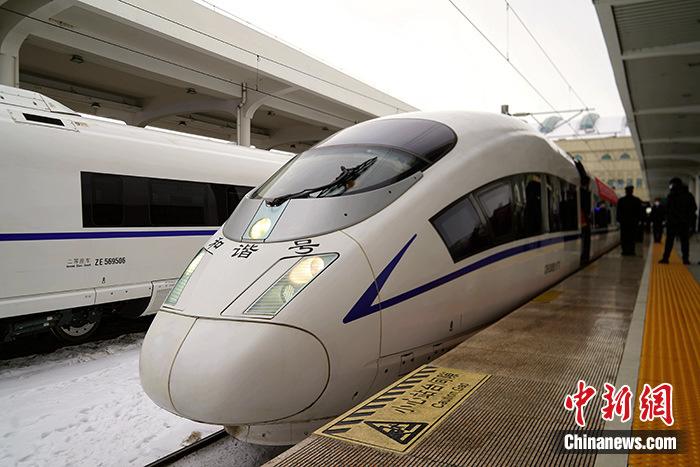China News Service, December 26. According to the official Weibo news of China National Railway Group Co., Ltd., starting from 0:00 on January 10, 2022, the national railways will implement a new train map, adding 96 pairs of passenger trains and adding more cargo. 65 pairs of trains.
After the adjustment of the map, the total number of passenger and freight trains in the country reached 5,231 and 10,606 respectively. The train operation structure has been continuously optimized, and the passenger and freight transportation capacity has been further improved.
Xintu passenger train tickets will be on sale from December 27th.
On December 6, China's easternmost high-speed rail-Mujia High-speed Railway was officially opened for operation, and the high-speed rail network in Heilongjiang Province was interconnected.
The data picture shows that the first train of Mujia High-speed Railway is about to leave the station at Mudanjiang Station.
Photo by Sun Hanlun issued by China News Agency
The main changes in this adjustment are reflected in:
The first is to make full use of new line resources such as China-Laos railway to further enhance regional transportation capacity.
The transitional operation diagram used when the new railway lines are opened in December 2021 will be adjusted to the official operation diagram for the first quarter, and the number of passenger and freight trains will be increased accordingly.
Among them, the Kunming-Mohan section of the China-Laos Railway has 28 pairs of mobile trains and 12 pairs of freight trains, 100 pairs of mobile trains on the Ganshen section of the Beijing-Hong Kong high-speed rail, and 24 pairs of mobile trains on the Anjiu section of the Beijing-Hong Kong high-speed rail. The Zhangjihuai high-speed rail has 28 pairs of action trains, the Mujia high-speed rail has 18 pairs of action trains, the Hangzhou-Taiwan high-speed rail has 35 pairs of action trains, and the Quzhuang section of the Japan-Lanzhou high-speed rail has operated 23 pairs of action trains.
After the map adjustment, the transportation capacity of Yunnan, Jiangxi, Anhui, Hunan, Heilongjiang, Zhejiang, Shandong and other regions has been further improved.
The second is to make full use of the new Beijing-Hong Kong high-speed rail channel to greatly shorten the time and space distance between the central and eastern regions and the Guangzhou-Shenzhen region.
Make full use of the newly formed southern section of the Beijing-Hong Kong high-speed rail after the opening of the Anjiu and Ganshen sections of the Beijing-Hong Kong high-speed rail, and adopt measures such as additional trains and extension of existing trains to increase the central and eastern regions of Nanchang, Hefei, Nanjing, Shanghai, etc. There are 48 pairs of EMU trains from the city to the Guangzhou-Shenzhen region, further enhancing the high-speed rail transportation capacity from the central and eastern regions to the Guangzhou-Shenzhen region, effectively shortening the space-time distance between the two places.
After adjusting the map, Nanchang West via Beijing-Hong Kong high-speed rail to Shenzhen North can be reached in 3 hours and 30 minutes, which is 1 hour and 8 minutes faster than the existing Shanghai-Kunming and Beijing-Guangzhou high-speed rail; Hefei South via Beijing-Hong Kong high-speed rail to Shenzhen, the fastest 6 It can be reached in 48 minutes, which is 2 hours and 15 minutes faster than the existing ECO-Fuzhou high-speed rail and Hangzhou-Shenzhen high-speed rail; Nanjing south via Ning'an, Anjiu high-speed rail and Changjiu intercity, Changgan high-speed rail, Ganshen high-speed rail to Shenzhen, the fastest It can be reached in 7 hours and 43 minutes, which is 3 hours and 07 minutes faster than the existing high-speed railways via Nanjing-Hangzhou, Hangchang, Hefu, Nanlong, Longzhang, and Hangzhou-Shenzhen; The fastest can be reached in 6 hours and 50 minutes, which is 1 hour and 14 minutes faster than the existing Shanghai-Kunming and Beijing-Guangzhou high-speed railways.
The third is to make full use of resources such as newly-added power centralized EMUs and speed lines to effectively increase passenger transportation capacity.
Use 25 newly-added power centralized EMUs to travel from Beijing to Harbin, Tangshan to Caofeidian, Qingdao to Yancheng, Handan to Jinan, Baotou to Lanzhou, Hohhot to Ordos, Xi'an to Ankang, Dazhou to Chengdu, Xingguo to Quanzhou, and Guangtong to On 14 existing general-speed lines including Kunming, 35 pairs of EMU trains were added.
Arrange the Nanning-Beihai railway to run at a speed of 250 kilometers per hour.
Continue to operate slow trains for public welfare, continue to promote the renovation of slow train equipment and facilities, and improve the level of serving people in remote mountainous areas.
The fourth is to coordinate the train operation structure of general-speed lines to effectively increase the cargo transportation capacity.
By optimizing the structure of passenger and freight trains on general-speed lines, adjusting some train routes, and using newly opened line resources, increase the operation of freight trains, improve freight capacity, and meet the needs of national and civilian bio-materials transportation such as electricity and coal and the needs of economic and social development.
After the map adjustment, 19 pairs of trucks were added to the Beijing-Shanghai, Lanxin, Xiangyu, and Longhai lines.
On the basis of maintaining 60 pairs of Tuding freight trains on the Haoji Line, 2 pairs of 10,000-ton heavy-duty trains were operated for the first time.
Continue to open the China-Europe Express, the Western Land-Sea New Corridor Express, and the China-Laos Railway Cross-border Freight Train to serve the international and domestic dual circulation and smooth trade.
The railway department reminded that the new map passenger train tickets will be on sale from December 27th. Passengers can inquire through the railway 12306 website, client, WeChat and other channels, and can also follow the dynamic information released by the railway departments and major trains. Station announcement to arrange the itinerary reasonably.

